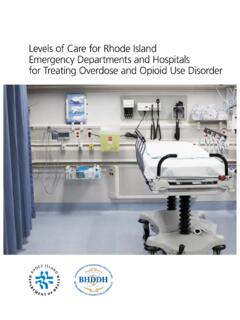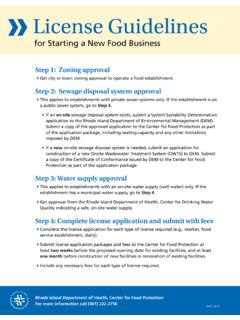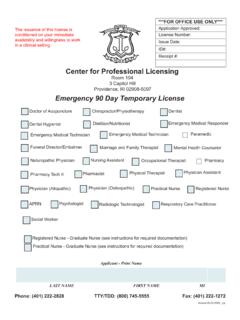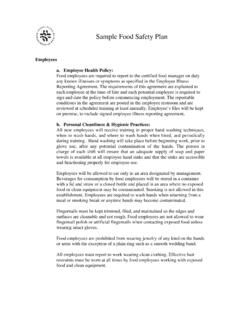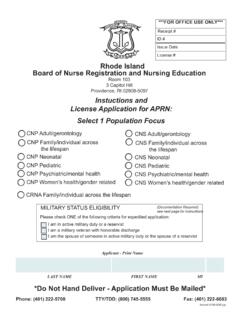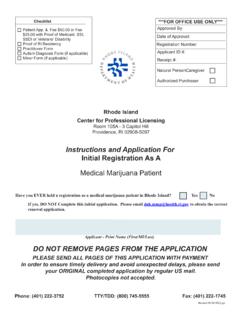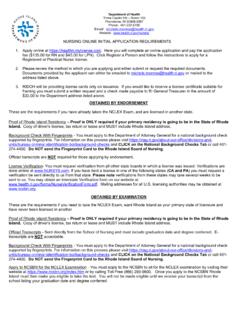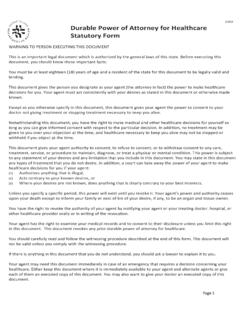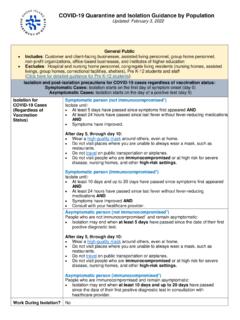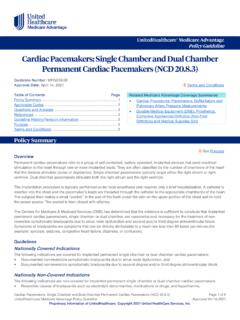Transcription of EMS Pharmacology Reference Guide - Rhode Island
1 Rhode Island Department of Health - Center for Emergency Medical Services EMS Pharmacology Reference Guide A companion to the 2017 Statewide Emergency Medical Services Protocols 1 RI Department of Health - Center for EMS - 2017 EMS Pharmacology Guide 2 RI Department of Health - Center for EMS - 2017 EMS Pharmacology Guide Preface This Reference Guide is released as companion to the 2017 Rhode Island Statewide Emergency Medical Services Protocols. It is intended to serve as a resource for EMS providers and training officers. EMS providers should acquire a fundamental understanding of Pharmacology related to their respective level of licensure/practice. Please provide any suggestions for future revisions of this document directly to John N.
2 Pliakas, MSN, NP, NRP, TP-C 3 RI Department of Health - Center for EMS - 2017 EMS Pharmacology Guide 4 RI Department of Health - Center for EMS - 2017 EMS Pharmacology Guide Table of Contents Acetaminophen 6 Activated charcoal 7 Adenosine 8 Albuterol 10 Amiodarone 12 Aspirin 14 Atropine sulfate 16 Calcium chloride 18 Calcium gluconate 20 Cefazolin 22 Dexamethasone 23 Dextrose (5%, 10%, 25%, 50%) 25 Diazepam 27 Diltiazem 29 Diphenhydramine 31 Dopamine HCL 33 Droperidol 35 Enalaprilat 37 Epinephrine 38 Etomidate (restricted use) 40 Famotidine 42 Fentanyl 44 Furosemide 46 Glucagon 47 Glucose (oral)
3 49 Haloperidol 51 Hydrocortisone 53 Hydroxocobalamin 55 Ibuprofen 56 Intravenous Fat Emulsion 20% 58 Ipratropium bromide 60 Ketamine 62 Ketorolac 64 Labetalol 66 Lactated Ringers Solution 67 Levalbuterol 70 Lidocaine 72 5 RI Department of Health - Center for EMS - 2017 EMS Pharmacology Guide Lorazepam 74 Magnesium Sulfate 76 Methylprednisolone 78 Metoprolol 80 Midazolam 82 Naloxone 84 Nicardipine 86 Nitroglycerin 87 Nitrous Oxide 89 Norepinephrine 91 Ondansetron 93 Oxygen 95 Oxymetazoline 99 Phenobarbital 100 Phenylephrine 101 Pitocin 103 Pralodoxime 104 Prednisone 106 Procainamide 107 Promethazine 109 Proparacaine 111 Pseudoephedrine 112 Rocuronium 113 Sodium bicarbonate 114 Sodium chloride 116 Sodium chloride 3% 118 Sodium thiosulfate 119 Succinylcholine (restricted use) 120 Terbutaline 123 Tetracaine 125 Thiamine 126 Tissue Plasminogen Activator (tPA) 127 Tranexamic acid (TXA) 130 Vecuronium 132 6 RI Department of Health - Center for EMS - 2017 EMS Pharmacology Guide Acetaminophen (Tylenol, APAP) Classification.
4 Analgesic, antipyretic General: Acetaminophen has analgesic and antipyretic properties with effects equivalent to those of aspirin. Its analgesic and antipyretics effects are likely the result from the inhibition of prostaglandin E2 (PGE2). It does not fall into the non-steroidal anti-inflammatory class of medications as it has no anti-inflammatory effects. Acetaminophen acts on a variant of cycloxygenase (COX3) that is only expressed in the central nervous system. Unlike aspirin, it has no effect on COX1 or COX2 and therefore, it has no effect on platelets. Acetaminophen elevates the pain threshold and readjusts the hypothalamic temperature regulatory center. Protocol Indication(s): 1. Mild to moderate pain 2.
5 Fever Contraindications: 1. Known hypersensitivity 2. Environmental hyperthermia Precautions: 1. Acetaminophen should be used with caution in patients with liver disease/failure. 2. The maximum adult daily dose of acetaminophen is 4,000 mg. Significant adverse/side effects: 1. Nausea/vomiting 2. Stevens-Johnson Syndrome (rare) 3. Toxic epidermal necrolysis (rare) Dosage per protocol(s): Patient Comfort - Adult Patient Comfort - Pediatric Fever - Adult Fever - Adult 7 RI Department of Health - Center for EMS - 2017 EMS Pharmacology Guide Activated Charcoal Classification: Gastric decontaminant General: Activated charcoal (AC) is charcoal which has been treated with oxygen, which results in the opening up of millions of pores between the charcoal s carbon atoms.
6 These pores directly absorb (bind) the molecules of a multitude of substances. In the EMS setting, AC is utilized as a single dose gastrointestinal decontaminant following the oral ingestion of a toxin (in the hospital, multiple doses are sometimes administered to enhance elimination of a toxin). There are a number of substances that are not chemically attracted to AC and are absorbed poorly if at all by AC. These include electrolytes, iron, lithium, heavy metals, acids or bases, alcohols, cyanide, most common solvents, and most water insoluble compounds such as hydrocarbons (petroleum distillates). Protocol Indication(s): 1. Oral toxic ingestion within 1 hour of EMS contact Contraindications: 1. Known hypersensitivity 2.
7 Patient with altered mental status without a protected airway ( not intubated) 3. Due to the increased risk of aspiration without out benefit, AC should not be administered following the ingestion of a substance known not to be absorbed by AC 4. Corrosive ingestion (AC obscures endoscopy, which is performed in such ingestions) unless there are life threatening co-ingestants which are adsorbed by AC Precautions: 1. Administration of AC increases the risk for aspiration. Significant adverse/side effects: 1. Nausea/vomiting 2. Intestinal obstruction (associated with the administration of multiple doses) Dosage per protocol(s): Toxicological Emergencies - Adult Toxicological Emergencies - Pediatric 8 RI Department of Health - Center for EMS - 2017 EMS Pharmacology Guide Adenosine (Adenocard) Classification: Antiarrhythmic General: Adenosine is a naturally occurring nucleoside found in all cells of the body.
8 Adenosine is byproduct of the breakdown of adenosine triphosphate (ATP). Adenosine specific receptors are located in the lungs and cardiomyocytes. Stimulation of these receptors results in decreased electrical conduction. As a result, SA node automaticity is decreased and conduction velocity is slowed and AV nodal refractoriness is increased. Adenosine terminates reentrant pathways that include the AV node as part of the circuit resulting in restoration of sinus rhythm in supraventricular tachycardia . In atrial fibrillation and flutter, adenosine may transiently increase AV block and unmask fibrillation or flutter waves. Adenosine does not convert atrial fibrillation, atrial flutter, or most forms of ventricular tachycardia and is not indicated in irregular tachycardias.
9 The administration of adenosine to a patient with atrial fibrillation and Wolff-Parkinson-White (WPW) Syndrome may result in ventricular fibrillation. Following IV administration, adenosine is rapidly taken up by erythrocytes and the vascular endothelium. Due to its rapid uptake, adenosine has a half-life of <2 seconds. The side effects of adenosine can be dramatic (sinus pause, asystole), but due to the very short half-life of the drug, they are usually transient in nature. The uptake of adenosine may be inhibited by some medications, such as dipyridamole (Persantine). If a patient is on dipyridamole, the dose of adenosine should be reduced. Some medications, such as theophylline and related methylxanthines (caffeine) act as antagonist at adenosine receptors.
10 The dose of adenosine may need to be increased if a patient is on one of these medications. Patients that are status post cardiac transplant may demonstrate increased sensitivity to adenosine. Protocol Indication(s): 1. Narrow complex tachycardia 2. Wide complex tachycardia (regular, monomorphic) Contraindications: 1. Known hypersensitivity 2. Atrial fibrillation associated with WPW Syndrome Precautions: 1. The administration of adenosine to a patient with atrial fibrillation and Wolff-Parkinson-White (WPW) Syndrome may result in ventricular fibrillation. 2. Adenosine may induce airway hyperresponsiveness and should be used with caution in patients with a history of reactive airway disease (asthma). 9 RI Department of Health - Center for EMS - 2017 EMS Pharmacology Guide Precautions: 3.
